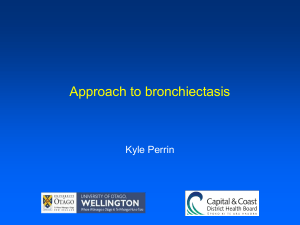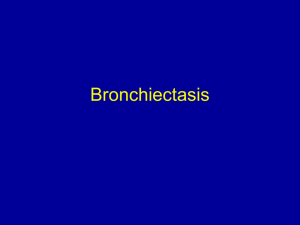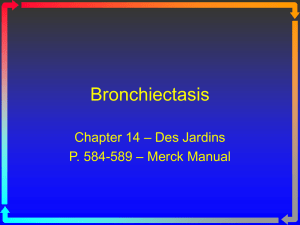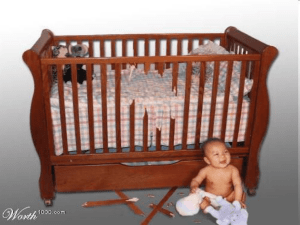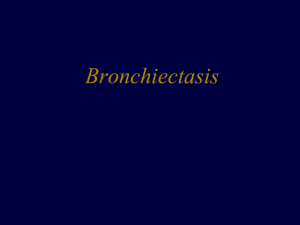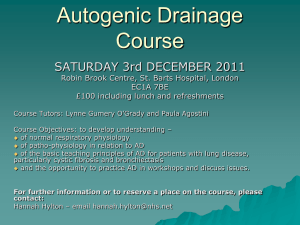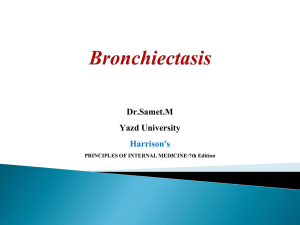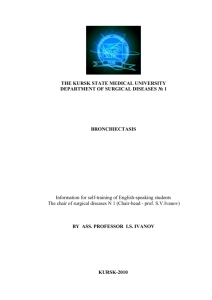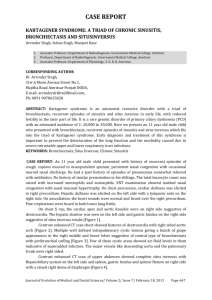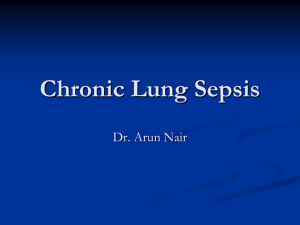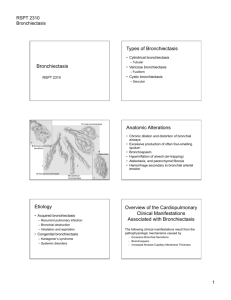Bronchiectasis
advertisement
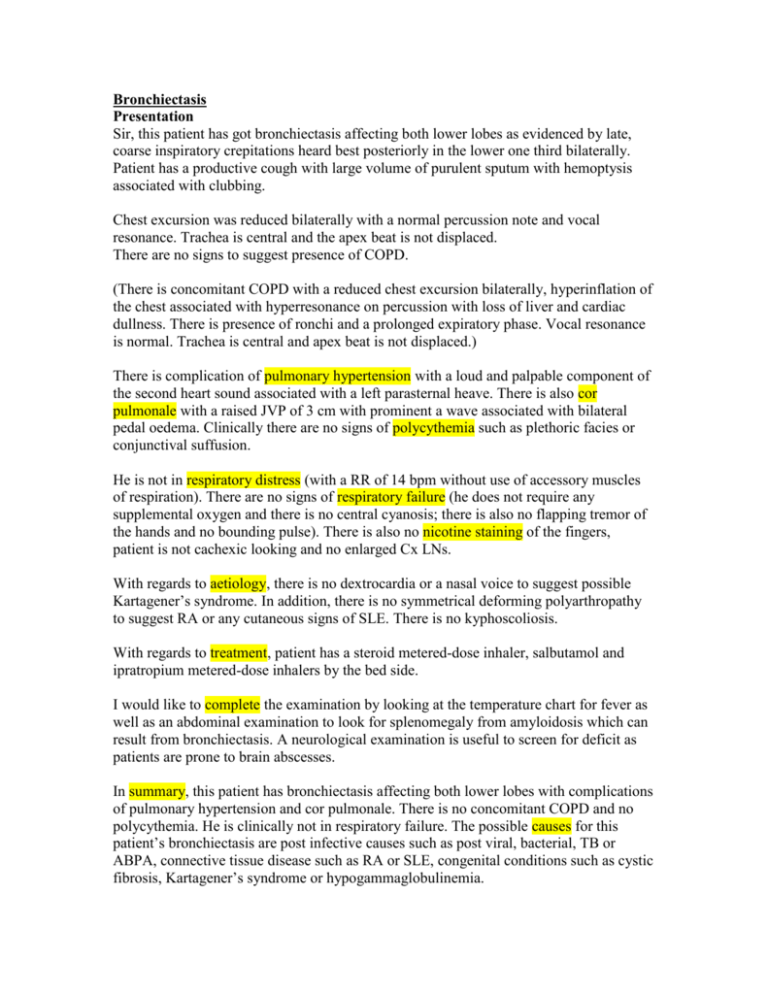
Bronchiectasis Presentation Sir, this patient has got bronchiectasis affecting both lower lobes as evidenced by late, coarse inspiratory crepitations heard best posteriorly in the lower one third bilaterally. Patient has a productive cough with large volume of purulent sputum with hemoptysis associated with clubbing. Chest excursion was reduced bilaterally with a normal percussion note and vocal resonance. Trachea is central and the apex beat is not displaced. There are no signs to suggest presence of COPD. (There is concomitant COPD with a reduced chest excursion bilaterally, hyperinflation of the chest associated with hyperresonance on percussion with loss of liver and cardiac dullness. There is presence of ronchi and a prolonged expiratory phase. Vocal resonance is normal. Trachea is central and apex beat is not displaced.) There is complication of pulmonary hypertension with a loud and palpable component of the second heart sound associated with a left parasternal heave. There is also cor pulmonale with a raised JVP of 3 cm with prominent a wave associated with bilateral pedal oedema. Clinically there are no signs of polycythemia such as plethoric facies or conjunctival suffusion. He is not in respiratory distress (with a RR of 14 bpm without use of accessory muscles of respiration). There are no signs of respiratory failure (he does not require any supplemental oxygen and there is no central cyanosis; there is also no flapping tremor of the hands and no bounding pulse). There is also no nicotine staining of the fingers, patient is not cachexic looking and no enlarged Cx LNs. With regards to aetiology, there is no dextrocardia or a nasal voice to suggest possible Kartagener’s syndrome. In addition, there is no symmetrical deforming polyarthropathy to suggest RA or any cutaneous signs of SLE. There is no kyphoscoliosis. With regards to treatment, patient has a steroid metered-dose inhaler, salbutamol and ipratropium metered-dose inhalers by the bed side. I would like to complete the examination by looking at the temperature chart for fever as well as an abdominal examination to look for splenomegaly from amyloidosis which can result from bronchiectasis. A neurological examination is useful to screen for deficit as patients are prone to brain abscesses. In summary, this patient has bronchiectasis affecting both lower lobes with complications of pulmonary hypertension and cor pulmonale. There is no concomitant COPD and no polycythemia. He is clinically not in respiratory failure. The possible causes for this patient’s bronchiectasis are post infective causes such as post viral, bacterial, TB or ABPA, connective tissue disease such as RA or SLE, congenital conditions such as cystic fibrosis, Kartagener’s syndrome or hypogammaglobulinemia. Questions What are your differential diagnoses for a patient that is clubbed and has crepitations? o Bronchiectasis o Pulmonary fibrosis o Mitotic lung lesion o Abscess What is bronchiectasis? o Definition: permanent dilatation of the bronchi o Pathology: Retained secretions and chronic inflammation o Clinical course: Chronic, progressive with recurrent infective exacerbations o Clinical: Symptoms - productive purulent cough, dyspnea and hemoptysis and Signs: coarse late inspiratory crepitations with a 3 layered purulent sputum What are the causes of bronchiectasis? o Focal o Luminal blockage – FB, broncholith o Arising from the wall – mitotic lesion of the lung o Extrinsic – enlarged LNs esp middle lobe from TB/fungi; displacement of airways post lobar resection o Diffuse o Post infectious conditions Bacteria – Pseudomonas, Hemophilus, Pertussis TB Aspergillus (for upper lobe or proximal bronchiectasis) as in allergic bronchopulmonary aspergillosis from type III immune complex reactions. Virus – adenovirus, measles, influenza o Congenital conditions Cystic fibrosis Alpha 1 Antitrypsin deficiency Kartagener’s syndrome of immotile ciliary syndrome Hypogammaglobulinemia o NB: Immunodeficiency form secondary causes such as cancer, chemotherapy or immune modulation post transplant o Rheumatic conditions RA (1-3% of patients) SLE Sjogren’s o Others Yellow nail syndrome (yellow nails, bronchiectasis, pl effusion and lymphedema) Young’s syndrome(secondary ciliary dyskinesia from mercury intoxication) Inflammatory bowel disease (UC or Crohn) Congenital kyphoscoliosis Idiopathic (50%) What is bronchiectasis sicca? o “dry” bronchiectasis o Presents with recurrent hemoptysis and dry cough o Affects the upper lobes therefore good drainage o Usually from past history of granulomatous infection eg TB What is Kartagener’s syndrome? o It is a type of immotile ciliary syndrome o Comprising of o dextrocardia, situs inversus o bronchiectasis, sinusitis, frontal sinus dysplasia, otitis media o infertility o Resulting in poor ciliary function with retained secretions and recurrent infections and thus bronchiectasis What is cystic fibrosis? o Most commonly due to mutations to CFTR (CF transmembrane conductance regulator) with F508 o Recurrent respiratory infections with pancreatic exocrine deficiency and short stature o Upper lobe involvement o Staph aureus, Ps aeuroginosa o Elevated sweat Na and Cl concentrations What are the differences in bronchiectasis vs COPD? o They may both occur concomitantly COPD Cause Cigarette Infection Secondary Organism S. pneumoniae, Haem Symptoms Dyspnea, chronic cough Sputum Mucoid clear CXR Hyperlucency, hyperinflated Bronchiectasis Infection, genetic Primary Haem, Pseudomonas Dyspnea, hemoptysis, productive 3 layered, purulent Airway thickening, dilated What are the complications of bronchiectasis? o Pneumonia, collapse, pleural effusion, lung abscess, pneumothorax, hemoptysis o Brain abscess o Sinusitis o Amyloidosis How would you investigate? The diagnostic investigation of choice is a HRCT but simple Ix such as CXR and LFT are also useful: o CXR – Diagnosis, extent and complications o 90% abnormal o Diagnosis specific dilated and thickened airways Ring shadows (seen on end) Tram lines Non-specific Linear or plate-like atelectasis Scattered irregular opacities Focal pneumonitis o Extent and distribution o Complications Pneumonia, abscesses, pleural effusion o Lung function test o Obstructive pattern with FEV1/FVC <70% o Severity of obstruction based on FEV1 o Reversibility with beta agonist 40% of patients have >15% improvement o High-resolution computer tomography scan of the thorax o Non-contrast study with 1 mm cuts every 1 cm with acquisition time of one second during full inspiration (requires patient cooperation); 90% sensitivity o Diagnostic Dilatation of airway lumen >1.5X cf to a nearby vessel Signet ring sign (dilated bronchus with its pulmonary artery) Lack of tapering of an airway toward the periphery with presence of bronchi within 1 cm from the pleura Reid’s classifications Cylindrical or tubular Varicose Saccular or cystic Useful also in elucidation cause of focal bronchiectasis o Assess distribution Usually lower lobes If upper lobes – suspect Cystic fibrosis or ABPA If proximal bronchiectis, ABPA If ML or lingula – M. avium complex o Complications How would you manage? o Non-Pharmacological o Education and counselling o Stop smoking, vaccinations (yearly influenza and 3-yearly pneumococcal) o Chest percussion and postural drainage (no evidence actually) o Rx underlying cause o Pharmacological o Rx acute exacerbations o O’Donnell’s 4/9 symptoms of exacerbations Increased dyspnea Increase cough Increase sputum production Increased wheezing Fever Lethargy, malaise Changes in chest sounds Reduced pulmonary function Radiographic changes consistent with a new pulmonary process o Antibiotics targeting Haem, Ps and Strep and Moraxella Fluoroquinolones Others MAC – Rifampiciin, ethambutol and Azithro till c/s negative for 1 year ABPA – augmentation of corticosteroids and use of itraconazole 200mg bd for 4 weeks then 200mg om for 4 more weeks o Bronchodilator therapy such as beta agonists and anticholinergics with inhaled corticosteroids o Improve lung function (FEV1) and reduce sputum volume o No effect on mortality o Aerosolised recombinant human DNAse for cystic fibrosis (not for other causes of bronchiectasis) o Surgery o Focal o Removal of obstructing tumour or FB o Diffuse o Segments that are most damaged and contributing to recurrent acute exacerbations o Segments involved with uncontrolled haemorrhage o Removal of segments suspected of harbouring drug resistant organism such as MDR MTB or MAC o Lung transplant How do you manage complication of hemoptysis? o Quantify o If >600mls /day = massive o Lie on the affected side o Protect airway o Bronchoscope or CT to determine site of bleed o Interventional radiology or surgical removal
